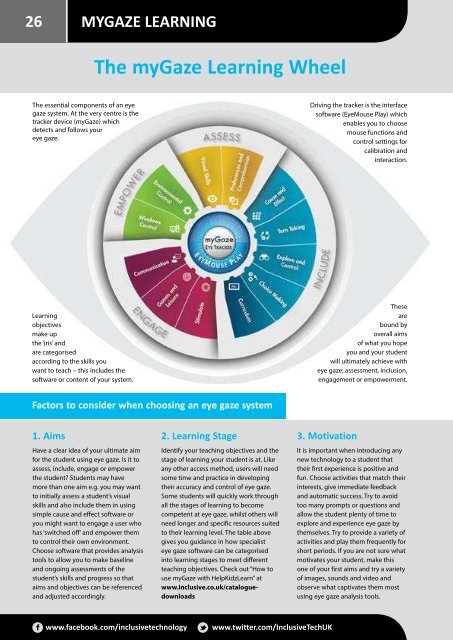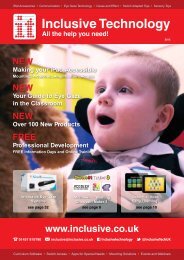2 HOW CAN WE HELP YOU? CONTENTS AND WELCOME 3
1KfMjDQ
1KfMjDQ
Create successful ePaper yourself
Turn your PDF publications into a flip-book with our unique Google optimized e-Paper software.
26 MYGAZE LEARNING MYGAZE LEARNING<br />
27<br />
The myGaze Learning Wheel<br />
Learning Stages Software<br />
The essential components of an eye<br />
gaze system. At the very centre is the<br />
tracker device (myGaze) which<br />
detects and follows your<br />
eye gaze.<br />
Driving the tracker is the interface<br />
software (EyeMouse Play) which<br />
enables you to choose<br />
mouse functions and<br />
control settings for<br />
calibration and<br />
interaction.<br />
Aim Learning Stage Software<br />
Assess<br />
Visual Skills<br />
Preferences and<br />
Comprehension<br />
Attention and Looking<br />
Attention and Looking / Exploring and Playing / Choosing and Learning<br />
Cause and Effect<br />
Attention and Looking / HelpKidzLearn / Sensory Eye-FX / Look to Learn<br />
Turn Taking<br />
Exploring and Playing / HelpKidzLearn<br />
Include<br />
Exploring and<br />
Control<br />
Exploring and Playing / Choosing and Learning / Eye Can Fly /<br />
HelpKidzLearn / Sensory Eye-FX / Look to Learn<br />
Choice Making<br />
Exploring and Playing / Choosing and Learning / Eye Can Fly /<br />
HelpKidzLearn / ChooseIt! Maker 3 / Look to Learn<br />
Curriculum<br />
Eye Can Fly / HelpKidzLearn / ChooseIt! Maker 3<br />
Stimulate<br />
Attention and Looking / HelpKidzLearn / Sensory Eye-FX<br />
Learning<br />
objectives<br />
make up<br />
the ‘iris’ and<br />
are categorised<br />
according to the skills you<br />
want to teach – this includes the<br />
software or content of your system.<br />
These<br />
are<br />
bound by<br />
overall aims<br />
of what you hope<br />
you and your student<br />
will ultimately achieve with<br />
eye gaze; assessment, inclusion,<br />
engagement or empowerment.<br />
Engage<br />
Empower<br />
Games and Leisure<br />
Communicate<br />
Windows Control<br />
Environmental Control<br />
Exploring and Playing / Eye Can Fly / HelpKidzLearn / Look to Learn<br />
Choosing and Learning / ChooseIt! Maker 3 / Grid 3<br />
Grid 3<br />
Grid 3<br />
Factors to consider when choosing an eye gaze system<br />
1. Aims<br />
2. Learning Stage<br />
3. Motivation<br />
4. Visual Skills<br />
5. Positioning<br />
6. Support and Training<br />
Have a clear idea of your ultimate aim<br />
for the student using eye gaze. Is it to<br />
assess, include, engage or empower<br />
the student? Students may have<br />
more than one aim e.g. you may want<br />
to initially assess a student’s visual<br />
skills and also include them in using<br />
simple cause and effect software or<br />
you might want to engage a user who<br />
has ‘switched off’ and empower them<br />
to control their own environment.<br />
Choose software that provides analysis<br />
tools to allow you to make baseline<br />
and ongoing assessments of the<br />
student’s skills and progress so that<br />
aims and objectives can be referenced<br />
and adjusted accordingly.<br />
Identify your teaching objectives and the<br />
stage of learning your student is at. Like<br />
any other access method, users will need<br />
some time and practice in developing<br />
their accuracy and control of eye gaze.<br />
Some students will quickly work through<br />
all the stages of learning to become<br />
competent at eye gaze, whilst others will<br />
need longer and specific resources suited<br />
to their learning level. The table above<br />
gives you guidance in how specialist<br />
eye gaze software can be categorised<br />
into learning stages to meet different<br />
teaching objectives. Check out “How to<br />
use myGaze with HelpKidzLearn” at<br />
www.inclusive.co.uk/cataloguedownloads<br />
It is important when introducing any<br />
new technology to a student that<br />
their first experience is positive and<br />
fun. Choose activities that match their<br />
interests, give immediate feedback<br />
and automatic success. Try to avoid<br />
too many prompts or questions and<br />
allow the student plenty of time to<br />
explore and experience eye gaze by<br />
themselves. Try to provide a variety of<br />
activities and play them frequently for<br />
short periods. If you are not sure what<br />
motivates your student, make this<br />
one of your first aims and try a variety<br />
of images, sounds and video and<br />
observe what captivates them most<br />
using eye gaze analysis tools.<br />
Before trying eye gaze, find out if the<br />
student has any recognised visual<br />
difficulty that could affect seeing<br />
images on screen. Most eye gaze<br />
devices cope well with different types<br />
of glasses (though special coated<br />
or vari-focal lenses may be less<br />
successful). Check for bright lights<br />
reflecting off screens and lenses or<br />
thick frames that could interfere<br />
with eye gaze detection. There is<br />
usually an option to track just one<br />
eye to compensate for physical eye<br />
movement difficulties. Eye gaze<br />
analysis tools can help in assessing<br />
basic visual skills such as detection,<br />
tracking, scanning and discrimination.<br />
With all access devices positioning is<br />
critical in achieving success. Ensure<br />
your student is positioned correctly<br />
according to guidance from your<br />
eye gaze device so that the tracker<br />
can easily detect their eyes and the<br />
student is comfortable and relaxed.<br />
To achieve this, some students may<br />
need a flexible mounting system to<br />
position the screen at the right angle<br />
and height. For others you may need<br />
to consider a portable system or a<br />
classroom resource that can be altered<br />
for a range of students. Try to consider<br />
who you are going to use it with,<br />
where will it be used and on what<br />
device at the onset.<br />
Setting up, using and adjusting eye<br />
gaze devices has often needed the<br />
support and guidance of experts in<br />
the field. At Inclusive Technology we<br />
believe that this process should be<br />
made as simple as possible so that<br />
more professionals and students can<br />
benefit from this amazing technology.<br />
We have worked hard to design<br />
and deliver easy to use, intuitive<br />
interfaces and software that require<br />
little or no training to use. However,<br />
it is still going to need the expertise<br />
and support of the team around<br />
the student to interpret results and<br />
provide the right resources and time<br />
allocation to ensure success.<br />
www.facebook.com/inclusivetechnology<br />
www.twitter.com/InclusiveTechUK<br />
Tel: 01457 819790 • Fax: 01457 819799 • Email: inclusive@inclusive.co.uk • www.inclusive.co.uk



